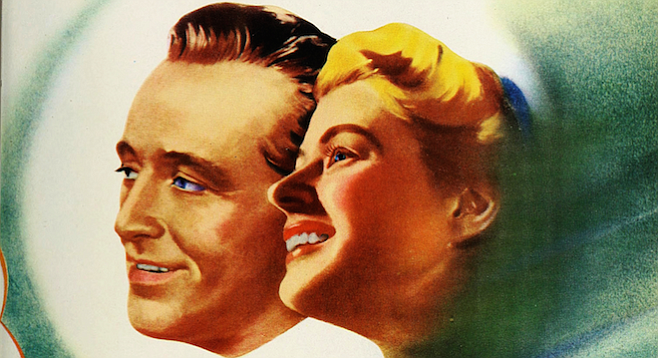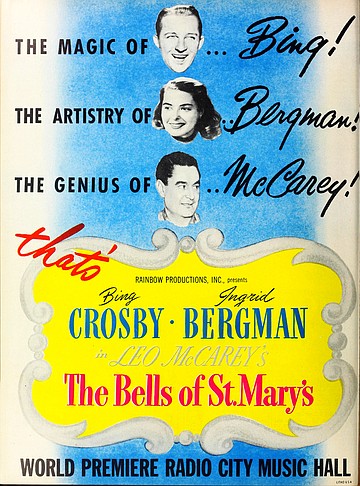 Facebook
Facebook
 X
X
 Instagram
Instagram
 TikTok
TikTok
 Youtube
Youtube

When asked to name a sequel that surpasses its original, The Godfather, Part II and The Bells of St. Mary’s are always the first to come to mind. (Exorcist II: The Heretic runs a close third.)
Long before the second installment of the Corleone family trilogy, Bells had the distinction of being the first sequel ever nominated for a best picture Oscar. Coincidentally, the title makes a standout cameo appearance splashed across the Radio City Musical Hall marquee in The Godfather.
Imagine yourself a contemporary filmmaker hired to tell the story of Father Chuck O’Malley (Casey Affleck in the role originated by Bing Crosby), a showbiz priest assigned a position at an urban parochial school following the former pastor’s mental breakdown brought about after spending years “up to his neck in nuns.” Once established, Father Chuck falls in love with tubercular nun Sister Mary Benedict (sinful Angelina Jolie subbing for saintly Ingrid Bergman), all the while helping a prostitute’s daughter (Miley Cyrus in the Joan Carroll part) get an education.
In addition to earning a compulsory G rating, the final cut has to be sprinkled with a handful of musical numbers including the lovely title tune and Jimmy Van Heusen and Johnny Burke’s Oscar-nominated standard, “Aren’t You Glad You’re You?”
In 1945, it would probably have been easier to film the Bible in real time than tell the story of a priest falling in love with a nun. In order for it to end happily in the eyes of the censors, Bergman had to die.

For director Leo McCarey, the success of The Bells of St. Mary’s seemed preordained. The story had been with him since childhood. His aunt, Sister Mary Benedict, helped build Hollywood’s Immaculate Heart Convent and died of typhoid fever. This was to be a follow-up to the director’s Paramount smash Going My Way. McCarey wrote the story before Going My Way, which was originally intended as Bells’ sequel.
Films about nuns are a tough sell to this yiddishe kop. Who wants to see Audrey Hepburn in The Nun’s Story when it’s made clear by the title that sparkling romance will never enter into it? Only McCarey, an artist who, according to Jean Renoir, understood people better than any Hollywood director, could have slipped this material past the censors.
It should come as no surprise that McCarey, the man credited with teaming Laurel with Hardy, was able to find delicate humor in the most unlikely of places. Father Chuck’s arrival at St. Mary’s is shown as a calamitous series of sight gags capped off by the original, and funniest, cat-in-the-hat act. Other laughs follow a dog yawning in church and a performance of the nativity story by an all-toddler cast.

Am I actually recommending a film rife with puppy dog and cuddly kitty cutaways, cute kids, and B-b-b-ing Crosby? You bet! I’ve come around to Crosby and for two hours believe him to be a munificent soul. (That’s acting!) In Going My Way, Bing is up to his big ears in a vat of sentimental goop almost on par with a visit to Boys Town. (Men of Boys Town is another sequel that’s leaps and bounds ahead of its predecessor, particularly when mined for unintentional howls.)
The Bells of St. Mary’s is anything but cloying. It’s insightful, heartfelt, and in many ways more uplifting than It’s a Wonderful Life. It even features Henry Travers, one film prior to gaining winged immortality as Capra’s Clarence.
Even though Going My Way brought Paramount needed recognition and bushels of cash, they chose not to pop for the sequel. Made under the banner of McCarey’s Rainbow Productions Inc., the film was distributed by R.K.O. In 1957, National Telefilm Associates obtained the theatrical rights and for years, all prints bore their logo. The U.S. video rights are controlled by Republic Pictures. Their otherwise immaculate copy not only lacks the introductory R.K.O. tower, but the telecine operator was instructed to obliterate all mention of the studio. They go so far as to graft a gray box over the studio name and copyright date on both the feature and its trailer.
The studio hired a Catholic priest to act in an advisory capacity during the shoot. Ing and Bing couldn’t resist having a little fun at his expense. When shooting was completed on their final farewell scene, the stars asked the director if they could do one more take. Just as the two were about to part, they moved in for a passionate goodbye kiss. The frantic offscreen advisor was the first and only priest ever to call “cut!” on a Leo McCarey set.
You’ll find even more talk of Bells in Joy to the Screen, a cover story compendium of Lickona and Marks’s favorite holiday movies.


When asked to name a sequel that surpasses its original, The Godfather, Part II and The Bells of St. Mary’s are always the first to come to mind. (Exorcist II: The Heretic runs a close third.)
Long before the second installment of the Corleone family trilogy, Bells had the distinction of being the first sequel ever nominated for a best picture Oscar. Coincidentally, the title makes a standout cameo appearance splashed across the Radio City Musical Hall marquee in The Godfather.
Imagine yourself a contemporary filmmaker hired to tell the story of Father Chuck O’Malley (Casey Affleck in the role originated by Bing Crosby), a showbiz priest assigned a position at an urban parochial school following the former pastor’s mental breakdown brought about after spending years “up to his neck in nuns.” Once established, Father Chuck falls in love with tubercular nun Sister Mary Benedict (sinful Angelina Jolie subbing for saintly Ingrid Bergman), all the while helping a prostitute’s daughter (Miley Cyrus in the Joan Carroll part) get an education.
In addition to earning a compulsory G rating, the final cut has to be sprinkled with a handful of musical numbers including the lovely title tune and Jimmy Van Heusen and Johnny Burke’s Oscar-nominated standard, “Aren’t You Glad You’re You?”
In 1945, it would probably have been easier to film the Bible in real time than tell the story of a priest falling in love with a nun. In order for it to end happily in the eyes of the censors, Bergman had to die.

For director Leo McCarey, the success of The Bells of St. Mary’s seemed preordained. The story had been with him since childhood. His aunt, Sister Mary Benedict, helped build Hollywood’s Immaculate Heart Convent and died of typhoid fever. This was to be a follow-up to the director’s Paramount smash Going My Way. McCarey wrote the story before Going My Way, which was originally intended as Bells’ sequel.
Films about nuns are a tough sell to this yiddishe kop. Who wants to see Audrey Hepburn in The Nun’s Story when it’s made clear by the title that sparkling romance will never enter into it? Only McCarey, an artist who, according to Jean Renoir, understood people better than any Hollywood director, could have slipped this material past the censors.
It should come as no surprise that McCarey, the man credited with teaming Laurel with Hardy, was able to find delicate humor in the most unlikely of places. Father Chuck’s arrival at St. Mary’s is shown as a calamitous series of sight gags capped off by the original, and funniest, cat-in-the-hat act. Other laughs follow a dog yawning in church and a performance of the nativity story by an all-toddler cast.

Am I actually recommending a film rife with puppy dog and cuddly kitty cutaways, cute kids, and B-b-b-ing Crosby? You bet! I’ve come around to Crosby and for two hours believe him to be a munificent soul. (That’s acting!) In Going My Way, Bing is up to his big ears in a vat of sentimental goop almost on par with a visit to Boys Town. (Men of Boys Town is another sequel that’s leaps and bounds ahead of its predecessor, particularly when mined for unintentional howls.)
The Bells of St. Mary’s is anything but cloying. It’s insightful, heartfelt, and in many ways more uplifting than It’s a Wonderful Life. It even features Henry Travers, one film prior to gaining winged immortality as Capra’s Clarence.
Even though Going My Way brought Paramount needed recognition and bushels of cash, they chose not to pop for the sequel. Made under the banner of McCarey’s Rainbow Productions Inc., the film was distributed by R.K.O. In 1957, National Telefilm Associates obtained the theatrical rights and for years, all prints bore their logo. The U.S. video rights are controlled by Republic Pictures. Their otherwise immaculate copy not only lacks the introductory R.K.O. tower, but the telecine operator was instructed to obliterate all mention of the studio. They go so far as to graft a gray box over the studio name and copyright date on both the feature and its trailer.
The studio hired a Catholic priest to act in an advisory capacity during the shoot. Ing and Bing couldn’t resist having a little fun at his expense. When shooting was completed on their final farewell scene, the stars asked the director if they could do one more take. Just as the two were about to part, they moved in for a passionate goodbye kiss. The frantic offscreen advisor was the first and only priest ever to call “cut!” on a Leo McCarey set.
You’ll find even more talk of Bells in Joy to the Screen, a cover story compendium of Lickona and Marks’s favorite holiday movies.
Comments